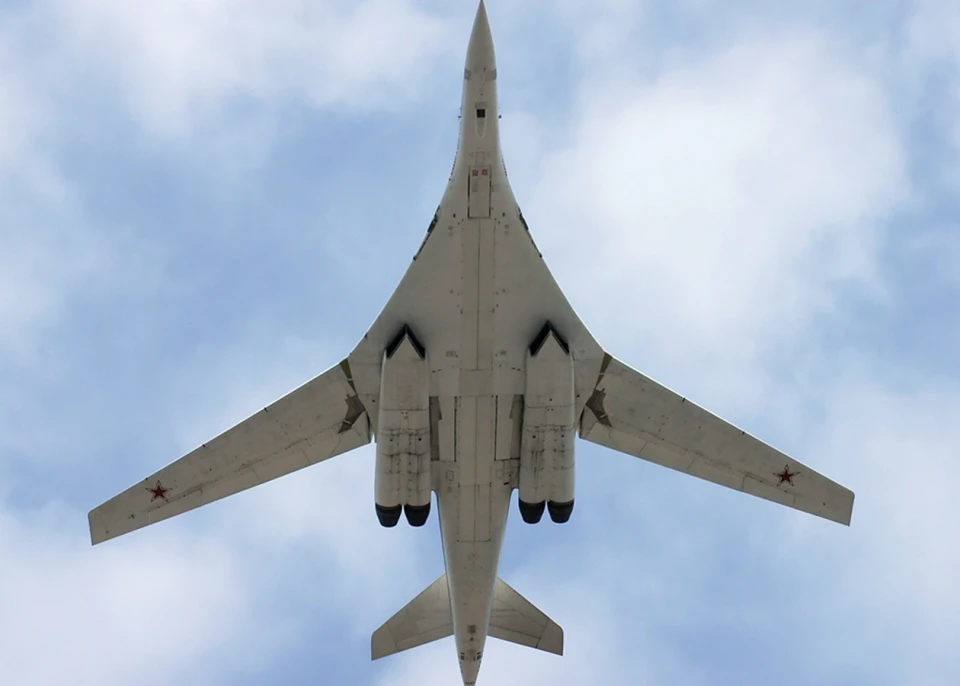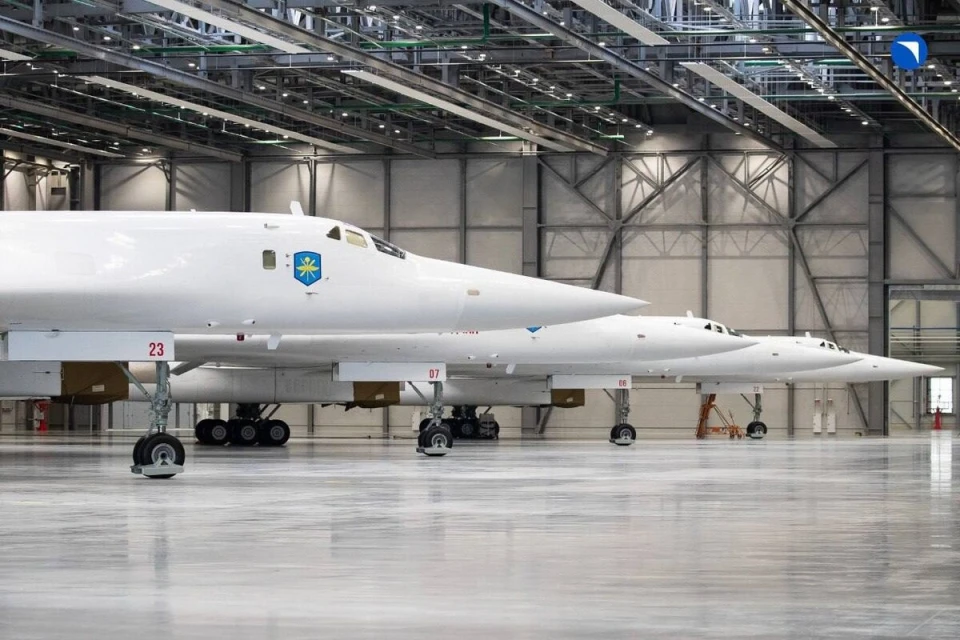
Tu-160 strategic bombers - aircraft Ukraine handed over to Russia and Kremlin is guarding like the apple of its eye
In April, Ukrainian intelligence targeted a Russian aviation plant in Kazan, where strategic bombers like the Tu-160M are produced
Briefly about the text:
- What is the Tu-160?
- Tu-160 technical characteristics
- Weapons the Tu-160 is equipped with
- How many Tu-160s did Ukraine have, and why give them up?
- How many Tu-160s Russia has, where they are deployed?
- Why Russia needs Tu-160 bombers?
What is the Tu-160?
The Tu-160 is a Soviet and Russian supersonic strategic bomber with variable-sweep wings. NATO codenames it Blackjack, while among pilots, it is nicknamed the "White Swan."
Developed in the 1970s, the aircraft made its first flight on December 18, 1981, and was commissioned in 1987. They are designed to strike high-priority targets with both nuclear and conventional weapons and are also used for long-range missions into enemy territory.
Since 2018, Russia has been working on the project to build an updated version called the Tu-160M, with the first aircraft taking to the skies in 2022.
Tu-160 technical characteristics
- Length - 54.1 m,
- Height - 13.1 m,
- Wingspan - variable (55.7 m, 50.7 m, 35.6 m),
- Crew - 4 people,
- Empty weight - 110 tonnes,
- Maximum take-off weight - 275 tonnes,
- Fuel weight - 148 tonnes,
- Maximum speed - 2000 km/h at altitude, 1030 km/h near the ground,
- Cruising speed - 850 km/h,
- Maximum range without refueling - 13.9 thousand km.
- The maximum range at supersonic speed is 2,000 km,
- Combat radius - 7300 km,
- Flight duration - up to 25 hours,
- Practical ceiling - 16 km.
- The four turbofan engines have a thrust of 14,000 kilograms at operating mode and 25,000 kilograms at afterburner.

Photo: Roszmі
Weapons the Tu-160 is equipped with
The Tu-160 strategic bomber was initially designed solely as a missile carrier for long-range cruise missiles with nuclear warheads. It can carry up to 12 cruise missiles, including the Kh-55, Kh-555, and Kh-101. Some of these missiles operate based on pre-programmed coordinates, while others can adjust their targets during flight. The missiles are housed in two rotary launchers, each accommodating six missiles, located in two cargo compartments of the aircraft.
For targets at shorter distances, the Tu-160 employs up to 24 air-launched ballistic missiles Kh-15. Additionally, after modification, the Tu-160 can carry up to 40,000 kg of free-fall bombs of various calibers, including bomb clusters, sea mines, and more.
Missiles from this bomber have repeatedly been used by the Russians to bombard Ukraine, in particular, attacking Lviv and Transcarpathian regions, as well as the capital.
How many Tu-160s did Ukraine have, and why give them up?
From its induction into service in 1987 and until the collapse of the USSR, 21 Tu-160 strategic bombers were deployed. Interestingly, only 2 of them were based in the Russian RSFSR, while 19 were stationed in Pryluky, Ukraine. After the dissolution of the Soviet Union, the aircraft located in the Chernihiv region came under the control of the Ukrainian Air Force.
However, Ukraine's military doctrine did not include strategic aviation. 10 aircraft were dismantled for scrap, and another 8 were handed over to Russia as "payment for gas debts." The last Tu-160 remains on display at the Museum of Heavy Bomber Aviation in Poltava.
Speaking about aircraft that once belonged to Ukraine, particular attention is given to the bombers transferred to Russia. Currently, they are being used to attack Ukraine, emphasized Vadym Skibitskyi, Deputy Chief of the Main Intelligence Directorate, in a comment to The New York Times. By the way, along with the Tu-160, Ukraine also transferred half a thousand Kh-55 missiles to Russia, which aggressors are actively utilizing during their full-scale invasion.
As for the reasons for the transfer of the bombers, Defence Express points to several reasons for this step. The first problem with the maintenance of these aircraft arose immediately - in 1991, only 25% of the flight crew and 60% of the technical staff swore allegiance to Ukraine.
"Russia began to throw spanners in the works, aiming to gain control of these bombers. For instance, the Tupolev Design Bureau suddenly backed out of its commitments to provide technical maintenance for Ukraine's Tu-160 aircraft. The shortage of qualified aviation technicians only exacerbated this issue," the material states.
Experts also point to the subjective inertia demonstrated by Ukraine's military-political leadership at the time. Consequently, on February 23, 2000, Ukraine completed the transfer of strategic bombers and over half a thousand cruise missiles to Russia, which were relocated to Engels in the Saratov region. In exchange, Russia provided aerodrome equipment and supposedly wrote off $285 million in "gas debts." The agreement was signed in 1999 in Yalta by Presidents Leonid Kuchma and Boris Yeltsin, with their autographs also accompanied by Prime Ministers Valeriy Pustovoitenko and Vladimir Putin.

Photo: Roszmі
How many Tu-160s Russia has, where they are deployed?
According to the Military Balance 2023, the Russian Aerospace Forces (VKS RF) have a total of 16 Tu-160 aircraft at their disposal. In March 2024, the Militarnyi portal estimated the number of "one-sixties" in Russia at 17 units.
"As of today, the Russian arsenal includes 6 Tu-160, 7 modernized Tu-160, and 4 Tu-160M aircraft. It is planned that the Russian defense-industrial complex will modernize an additional 6 Tu-160 aircraft. Frankly speaking, Russian plans to manufacture 30 Tu-160M aircraft are unrealistic," the material states.
In February, Russian propagandists showcased a video from the Kazan Aviation Plant, where Putin was shown four Tu-160M aircraft in one hangar. However, it later turned out that not all the aircraft demonstrated to the Kremlin leader were new. Moreover, the modernization of the bombers itself is questionable. Defense Express pointed out that what is being presented as a "completely new" Tu-160M2 is actually a product assembled under the "reproduction" program (meaning aircraft assembled from nearly 40-year-old Soviet parts).
The aircraft are stationed at the 121st Guards Aviation Regiment in Engels, comprising nine Tu-160 and seven Tu-160M. Each of them bears a name, such as "Ilya Muromets," "Igor Sikorsky," or "Nikolay Kuznetsov." However, after several successful attacks by Ukraine on the airfield in Engels, Russia is attempting to hide the Tu-160 as far away from their permanent base as possible, relocating them to more distant airfields. It's worth noting that only large airfields with extensive equipment are suitable for hosting these "strategists."
“It took 64 man-hours of preparatory work to get one Tu-160 ready for a flight. And 15-20 special vehicles for various purposes, including vehicles with mobile air conditioning, at least three TK-60 fuel tankers and fuel nitriding units, and an optional minibus with a ventilation system for high-altitude crew suits. The noise during the preparation of the aircraft for flight could reach 130 decibels, and the noise from the launch of the auxiliary power unit allegedly exceeded the pain threshold by 45 decibels,” wrote Defense Express.

Photo: from open sources
Why Russia needs Tu-160 bombers?
At the end of March, the head of Ukraine's Intelligence Directorate, Kyrylo Budanov, mentioned the Tu-160. He pointed out how much the Russians cherish these bombers. According to him, the Russians currently use mainly Tu-95s and occasionally Tu-22s to launch missiles at Ukraine. But Tu-160 aircraft have not been used for a long time.
"The Tu-160 aircraft haven't been seen on combat missions for quite some time now. Missiles are exclusively launched from the Tu-95. The Tu-160s are not utilized—they are being preserved to the maximum," emphasized the intelligence chief.
Such Russian behavior is easy to explain. The bombers were designed to combat NATO and specifically the United States. To wage war with Ukraine, using aircraft with a combat radius exceeding 7,000 km is not necessary. Moreover, Russia constantly seeks to intimidate potential adversaries by showcasing the Tu-160.
In 2018, Moscow dispatched one of the aircraft to Venezuela. However, the US Ambassador to Colombia, Kevin Whitaker, referred to the Russian supersonic strategic bombers as "museum exhibits from the 80s." Just a year later, Russia deployed Tu-160s to Chukotka, directly near the borders with the US. Then, in 2021, Russia conducted maneuvers over the Baltic Sea, where long-range reconnaissance aircraft Su-50s, two Tu-160 bombers, and escort fighters were flying. NATO scrambled aircraft from air bases in Estonia, Lithuania, and Poland to intercept them.
However, Russia's desire to threaten both Ukraine and NATO simultaneously pushes it towards unclear decisions. Defense Express referred to the placement of strategic aviation, including the Tu-160, at the Olenegorsk airfield as "strategic paralysis."
"The point is that the Olenegorsk air base is located just 150 km from the new NATO border in the form of Finland. What is 150 km? It's not just the range of impact for tactical aviation's cruise missiles or ATACMS, but also for "air-to-air" missiles directly from NATO's airspace. And, of course, being within the surveillance zone of radar systems and electronic reconnaissance means. In other words, Russian strategic aircraft at this airfield will never be able to unexpectedly take off into the air for the enemy and are within the range of all means for guaranteed destruction, both on the ground and in the air," explained in the material.
"So, Olenya in the USSR was a base only for naval aviation, but by no means for strategic aviation. Whereas NATO borders in Soviet times were much further away than the border between Russia and Finland."
- News














































